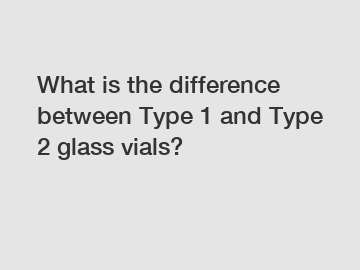Dec. 25, 2023
Packaging & Printing
What is the difference between Type 1 and Type 2 glass vials?
When it comes to selecting glass vials for pharmaceutical packaging, understanding the difference between Type 1 and Type 2 glass is crucial. Type 1 and Type 2 vials are classified based on their composition and degree of hydrolytic resistance. This classification ensures the compatibility of the glass with pharmaceutical products, minimizing the risk of leaching and contamination. In this article, we will delve into the characteristics, testing, and significance of Type 1 and Type 2 glass vials in pharmaceutical packaging.
Type 1 glass is known as borosilicate glass and is the highest quality glass used for pharmaceutical packaging. It is composed of silica and boron trioxide, which imparts its exceptional hydrolytic resistance. This resistance ensures that the glass does not interact with or leach any chemicals into the pharmaceutical product, maintaining its purity. Type 1 glass vials are ideal for storing sensitive drugs and vaccines that require long-term stability. This glass also has low alkalinity and a high resistance to thermal shock, making it suitable for high-temperature sterilization processes.

On the other hand, Type 2 glass refers to soda-lime-silica glass, which is less resistant to hydrolysis compared to Type 1 glass. It contains higher amounts of sodium and calcium oxides, making it more alkaline. While Type 2 glass can still be used for pharmaceutical packaging, it is not recommended for long-term storage or for highly sensitive drugs. This is because it has a higher potential to leach alkali ions into the pharmaceutical product, which may compromise its stability and efficacy. However, Type 2 glass vials are cost-effective and suitable for packaging non-critical medications or those with a short shelf life.
To ensure the quality and reliability of glass vials, various tests are conducted on Type 1 and Type 2 glass. These tests include hydrolytic resistance, pH measurement, and chemical durability evaluation. Type 1 glass vials undergo more stringent testing to meet the requirements of the United States Pharmacopeia (USP) and the European Pharmacopoeia (EP). They must exhibit excellent resistance to hydrolytic degradation under various pH conditions, ensuring the preservation of the drug and patient safety. In contrast, Type 2 glass vials undergo less rigorous testing, as their composition is not as stable as Type 1 glass.
The difference between Type 1 and Type 2 glass vials is of great importance in pharmaceutical packaging. By selecting the appropriate type of glass, manufacturers can ensure the integrity and stability of their products. Type 1 glass vials are essential for storing sensitive drugs and vaccines, where purity and long-term stability are critical factors. Conversely, Type 2 glass vials provide a cost-effective solution for non-critical medications with shorter shelf lives. Understanding the distinctions between these glass types enables pharmaceutical companies to make informed choices, mitigating any risks associated with the leaching of impurities or compromised drug efficacy.
In conclusion, the difference between Type 1 and Type 2 glass vials lies in their composition, hydrolytic resistance, and suitability for pharmaceutical packaging. Type 1 glass offers superior resistance to hydrolysis, making it ideal for storing sensitive drugs, while Type 2 glass is more alkaline and less resistant to degradation. The selection of glass vials is crucial in maintaining the integrity and stability of pharmaceutical products, ensuring patient safety and enhancing the overall quality of healthcare.
If you are looking for more details, kindly visit glass tubing suppliers, borosilicate 5.0 glass tube, Screw-Neck Vials manufacturer.
If you are interested in sending in a Guest Blogger Submission,welcome to write for us!
All Comments ( 0 )